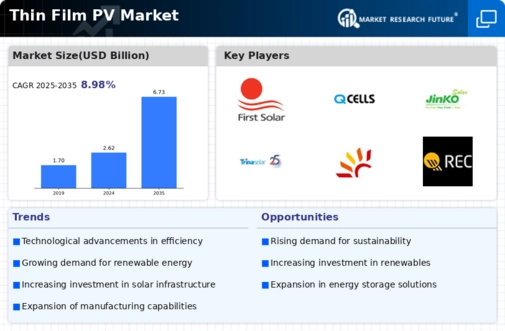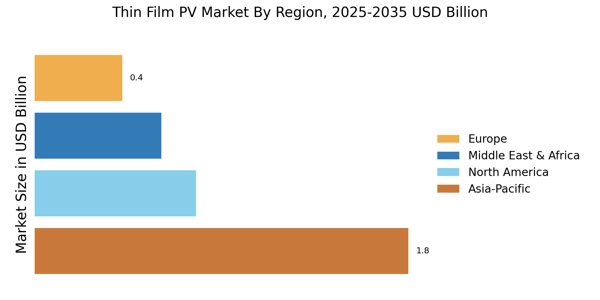Rising Awareness of Energy Independence
The Thin Film PV Market is experiencing a heightened awareness of energy independence among consumers and businesses. As energy prices fluctuate and geopolitical tensions impact energy supply chains, the desire for self-sufficiency in energy generation is becoming more pronounced. Thin film photovoltaic technology offers a practical solution for achieving energy independence, as it can be deployed in various settings, including remote areas and off-grid locations. The ability to generate electricity on-site reduces reliance on traditional energy sources and enhances energy security. In 2025, it is anticipated that this trend will continue to gain momentum, with more individuals and organizations seeking to invest in thin film solar solutions. Consequently, the Thin Film PV Market is likely to thrive as energy independence becomes a priority for many, driving demand for innovative solar technologies.
Growing Demand for Renewable Energy Sources
The Thin Film PV Market is witnessing a surge in demand for renewable energy sources, driven by increasing awareness of climate change and the need for sustainable energy solutions. Governments and organizations are setting ambitious renewable energy targets, with many aiming for a significant percentage of their energy mix to come from solar power. In 2025, it is estimated that solar energy could account for over 20% of the total energy generation in several regions. This growing demand is likely to propel the Thin Film PV Market forward, as thin film technology offers a flexible and lightweight alternative to traditional solar panels. The ability to integrate thin film PV systems into various surfaces, such as building facades and rooftops, enhances their appeal. Consequently, the Thin Film PV Market is expected to benefit from this increasing emphasis on renewable energy adoption.
Cost-Effectiveness of Thin Film PV Technology
The Thin Film PV Market is experiencing a notable shift towards cost-effective solar solutions. Thin film photovoltaic technology, characterized by its lower manufacturing costs compared to traditional silicon-based solar cells, is becoming increasingly attractive. The average cost of thin film solar modules has decreased significantly, with prices dropping by approximately 30% over the past five years. This reduction in costs is primarily due to advancements in production techniques and economies of scale. As a result, the Thin Film PV Market is poised for growth, particularly in regions where budget constraints are a primary concern. Furthermore, the lower material usage in thin film technology contributes to its cost-effectiveness, making it a viable option for both residential and commercial applications. This trend suggests that the Thin Film PV Market may continue to expand as affordability becomes a key driver for adoption.
Supportive Government Policies and Incentives
The Thin Film PV Market is benefiting from supportive government policies and incentives aimed at promoting renewable energy technologies. Many countries are implementing favorable regulations, tax credits, and subsidies to encourage the adoption of solar energy solutions. For example, feed-in tariffs and net metering programs are becoming increasingly common, providing financial incentives for consumers to invest in thin film solar systems. In 2025, it is projected that these policies will continue to evolve, further stimulating the Thin Film PV Market. The alignment of government objectives with renewable energy goals is likely to create a conducive environment for the growth of thin film technology. As a result, the Thin Film PV Market may see increased participation from both residential and commercial sectors, driven by the financial benefits associated with government support.
Technological Innovations Enhancing Efficiency
Technological innovations are playing a pivotal role in the Thin Film PV Market, enhancing the efficiency and performance of thin film solar cells. Recent advancements in materials science, such as the development of new semiconductor materials, have led to improved energy conversion efficiencies. For instance, some thin film technologies are now achieving efficiencies exceeding 20%, which is comparable to traditional silicon-based cells. These innovations not only boost the performance of thin film solar panels but also expand their applicability in various environments. As efficiency continues to improve, the Thin Film PV Market is likely to attract more investments and research funding, further driving growth. The ongoing pursuit of higher efficiency levels suggests that the Thin Film PV Market may evolve rapidly, adapting to the changing needs of consumers and industries alike.


















Leave a Comment